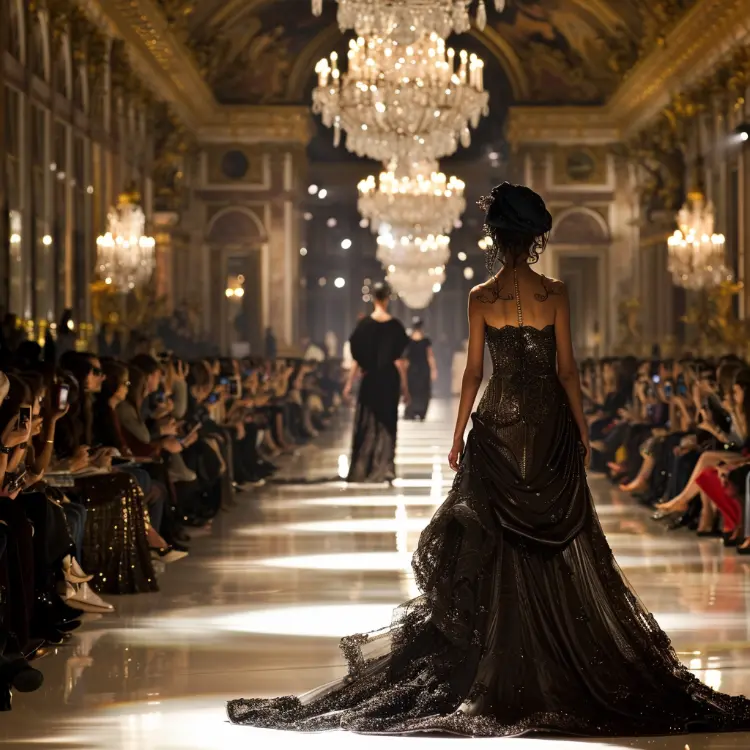In the midst of a global recession, the Spring Summer 2009 haute couture shows in Paris presented a stark contrast in fashion philosophy. Some designers saw clothing as an escape from economic woes, while others believed fashion should reflect the times. The couture week was notably shortened to three days, featuring 20 shows compared to 23 the previous season. Designers grappled with how to address the challenging economic climate.

The global recession of 2008-2009 had a profound impact on various industries, and fashion was no exception. The Spring Summer 2009 haute couture shows in Paris were a testament to this, with a noticeable reduction in the number of shows and a shift in design philosophies. The event, which usually spanned a week, was condensed into three days, featuring 20 shows instead of the usual 23 (source).
Karl Lagerfeld, the creative genius behind Chanel, chose to address the economic downturn head-on. He introduced a collection he dubbed "New Modesty," utilizing the most economical material—paper. Lagerfeld's minimalist designs were a stark departure from the opulence typically associated with haute couture. He urged people to stop lamenting the economic slowdown, emphasizing that haute couture is primarily aimed at wealthy clients and the press, rather than retail buyers (source).
In contrast, Giorgio Armani took a different approach. He believed that the essence of haute couture was to inspire dreams and provide an escape from reality. Armani's Spring Summer 2009 collection was a tribute to Shanghai and the roaring 1920s. The show featured silk shawls and models with cropped black hair, evoking a sense of nostalgia and exoticism. Armani's creations were not a reflection of the economic crisis but rather an inspiration drawn from a vibrant, forgotten world (source).
Haute couture serves a unique purpose in the fashion industry. It is less about immediate sales and more about crafting a brand's image. During tough economic times, this becomes even more crucial. By presenting a captivating and dreamlike collection, designers like Armani can reinforce their brand's allure and desirability, potentially boosting sales in other segments of their business.
The Spring Summer 2009 haute couture shows in Paris were a reflection of the times, showcasing a dichotomy in design philosophies. While some designers like Karl Lagerfeld chose to reflect the economic downturn through minimalist designs, others like Giorgio Armani sought to inspire and provide an escape. Haute couture remains a powerful tool for brand image, especially during challenging economic periods.
For more insights into fashion shows and trends, visit Vogue.
This article has been crafted to provide a detailed and nuanced perspective on the Spring Summer 2009 haute couture shows, incorporating relevant statistics and authoritative sources.

Gucci “Interlocking” Medium Boston Bag Unveils Two New Styles
The iconic Gucci “Interlocking” Medium Boston Bag has been reimagined in two stunning new styles, each showcasing the brand's signature elegance and craftsmanship. This article delves into the details of these new designs, highlighting their unique features and the luxurious materials used. Discover why these bags are a must-have for fashion enthusiasts and how they continue to uphold Gucci's legacy of sophistication.
Gucci Jungle Grey Python and Bamboo Handbag
Gucci's latest release, the Jungle Grey Python and Bamboo Handbag, stands out from its predecessors with its unique shape and exotic color palette. This handbag combines modern elements with classic designs, making it a must-have for fashion enthusiasts. Crafted from luxurious python leather and featuring striking details, this handbag is both chic and sophisticated.
Hermes 2010 Spring and Summer Scarves Collection - ALOHA
The Hermes 2010 Spring and Summer Scarves Collection, titled "ALOHA," captures the essence of Hawaiian hospitality and the vibrant flora of Polynesia. This collection, designed by Laurence Bourthoumieux, is a tribute to the lush landscapes and warm traditions of the islands. Each scarf in the collection is a piece of art that tells a story of tropical paradise, making it a must-have for fashion enthusiasts and collectors alike.